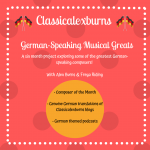Ruth Schönthal: Sonata Concertante
Context
Originally written to be played on either a cello, viola or clarinet, Ruth Schönthal’s Sonata Concertante was composed in 1973. Now fondly remembered as a work for clarinet and piano, that is the version this blog will discuss. There aren’t many records regarding this work, although it has been recorded a handful of times, most of which are by clarinettists.
Sonata Concertante is set into three movements and shows the clarinet and piano in contrasting characters.
Movement I – Tempo Rubato
After the aggressive opening piano chords, the piano dies away to make room for the fanfaring clarinet. For over a minute the two instruments never play together, only in response to each other. When they do unite the clarinet plays a lyrical melody above a jaunty and staccato arpeggio-like accompaniment from the piano. A climax is reached before the music begins to die away once more.
Throughout this opening the movement, Schönthal’s music is not necessarily what you might expect from her style at this time. The lyricism throughout is somewhat uncomfortable due to her use of syncopation between the instruments. The two instruments both get time to play solo, as well as playing in both unison as well as like a soloist and accompanist.
The first movement ends with a small reprise of some of the opening material, as the instruments continue to flirt with one another in extremities of range. The quiet ending in the lower range leaves a haunting feeling that is one of the most magical parts of the whole suite.
Movement II – Slow, calm and with great expression
With the piano opening the second movement once more, the atmosphere has shifted to an even darker place. Schönthal’s use of dissonance in the piano creates an exciting dichotomy with the clarinet, who is largely tonal and conventional throughout.
The lyrical clarinet solo sits just above the rumbling accompaniment, although the ranges of the instruments often overlap, creating quite a muddy texture throughout. There is a sense of sweetness in the middle section, with the clarinet leading on this character. The fluctuating piano theme adds a strange motion to the underlying rhythm of the movement.
As the performance directions indicate, the calmness of this movement must come through great expression. There is a sense of sereness at points of the movement, however this does not always last. There is a sense of agitation throughout parts too, although this does not disrupt the calmness too much. The second movement, similar to the first, ends with instruments both rumbling together, before the clarinet plays a cadenza-like section that leads into a quick silence before the third movement begins.
Movement III – Allegro Moderato
There is an instant sense of innocence in the first part of the finale movement. We’ve shifted back into tonality for a short while and a sweet clarinet bursts out with a memorable theme. The tension begins to build between the two instruments before a big climax that results in a short silence.
After the silence the pari come back in with another playful interlude. The scalic accompaniment and the swirling clarinet solo creates a nostalgic and innocent atmosphere, which begins to fade as the instruments build in climax once more. The tension builds and the atmosphere soon turns more aggressive before another short silence.
Again, after the silence the pair enter together, both teasing each other with playful interlocking melodies before the aggressive final few notes.
Final Thoughts
Ruth Schönthal’s Sonata Concertante is a really exciting work that exploits different atmospheres and characters through the clarinet and piano. From the lyrical melodies to the intense climaxes between the instruments, Sonata Concertante is full of exciting twists and turns.
Ⓒ Alex Burns
Happy Reading!
You might also enjoy… Alban Berg: Vier Stücke
*This blog is part of the ‘German-Speaking Musical Greats Project’ 2019-20

Recommended Recordings:


0 Comments